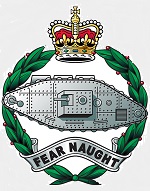Dragon DRR60250 Dragon Expo '06: British Sherman Firefly Mk. Vc Medium Tank - Turret Gunner Douglas Kay, "Carole", 13th/18th Royal Hussars, 27th Armoured Brigade, France, 1944 (1:72 Scale)
"The only way you can win a war is to attack and keep on attacking, and after you have done that, keep attacking some more."
- General George S. Patton Jr., January 1945
 The M4 Sherman medium tank was regarded by many as the workhorse of the US Army during World War II. In fact, virtually all of the Allied armies employed the Sherman in their armed forces, including the British, who developed an upgunned variant called the "Firefly". Eleven different US plants manufactured six basic models of the Sherman, and by June 1944 over 49,234 battle-ready vehicles had been produced. While it was no match for the German Panther or Tiger tanks, the Sherman soldiered on, using its weight in numbers to wrest control of Europe from the Wehrmacht.
The M4 Sherman medium tank was regarded by many as the workhorse of the US Army during World War II. In fact, virtually all of the Allied armies employed the Sherman in their armed forces, including the British, who developed an upgunned variant called the "Firefly". Eleven different US plants manufactured six basic models of the Sherman, and by June 1944 over 49,234 battle-ready vehicles had been produced. While it was no match for the German Panther or Tiger tanks, the Sherman soldiered on, using its weight in numbers to wrest control of Europe from the Wehrmacht.
Early Shermans mounted a 75mm medium-velocity general-purpose gun. Later M4A1, M4A2, and M4A3 models received the larger T23 turret with a high-velocity 76mm gun M1, which traded reduced HE and smoke performance for improved anti-tank performance. The British offered the QF 17 pounder (76.2 mm) anti-tank gun with its significant armour penetration but a significant initial (later rectified) HE shortcoming to the Americans but the US Ordnance Department was working on a 90mm tank gun and declined. Later M4 and M4A3 were factory-produced with a 105mm howitzer and a new distinctive mantlet in the original turret. The first standard-production 76mm-gun Sherman was an M4A1 accepted in January 1944 and the first standard-production 105mm-howitzer Sherman was an M4 accepted in February 1944.
Pictured here is the 1:72 scale Sherman Firefly offered at the Dragon '06 Europe show whereby Douglas Kay served as its turret gunner.
Sold Out!
Dimensions:
Length: 3-1/4-inches
Width: 1-1/2-inches
Release Date: November 2006
Historical Account: "Queen Mary's Own" - The 27th armoured brigade was formed from the conversion of the 1st Armoured Reconnaissance Brigade on November 26th, 1940, and attached to the 9th Armoured Division. While based in the United Kingdom the brigade was used to experiment with specialized armoured vehicles.
On September 8th, 1942, it was attached to the 79th Armoured Division until October 20th, 1943, when it was attached to the 3rd Infantry Division for the Normandy Landings. The brigade landed at Sword Beach as part of I Corps and fought in the Caen area until disbanded on July 30th, 1944.






